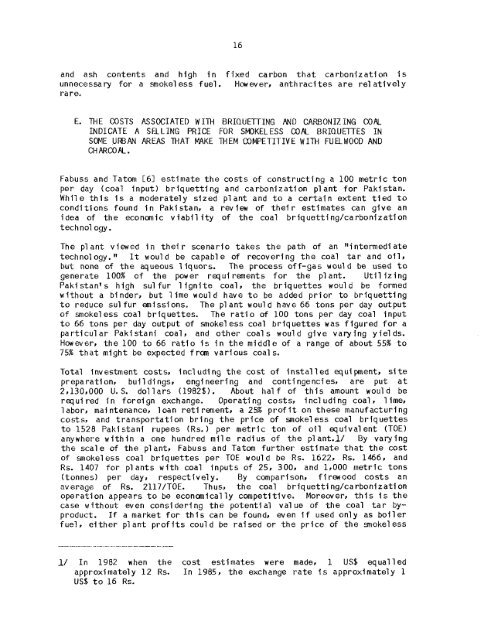Prospects for Coal Briquettes as a Substitute Fuel for Wood and ...
Prospects for Coal Briquettes as a Substitute Fuel for Wood and ...
Prospects for Coal Briquettes as a Substitute Fuel for Wood and ...
You also want an ePaper? Increase the reach of your titles
YUMPU automatically turns print PDFs into web optimized ePapers that Google loves.
16<br />
<strong>and</strong> <strong>as</strong>h contents <strong>and</strong> high in fixed carbon that carbonization is<br />
unnecessary <strong>for</strong> a ,smoke1 ess fuel. Hwever, anthracites are re1 atively<br />
rare.<br />
E. THE COSTS ASSOCIATED WITH 3RIQUETTING PND CARBONIZING COAL<br />
INDICATE A SELLING PRICE FOR SNOKELESS COAL BRIQUETTES IN<br />
SOME URBAN AREAS THAT MAKE THEM CX)MPETITIVE W I T H FUELWOOD AND<br />
CHrnCQK.<br />
Fabuss <strong>and</strong> Tatm C6l estimate the costs of constructing a 100 metric ton<br />
par day (coal input) briquetting <strong>and</strong> carbonization plant <strong>for</strong> Pakistan.<br />
Whdfo this is a moderately sized plant <strong>and</strong> to a certaln extent tied to<br />
conditions found in Pakistanr a review of their estimates can give an<br />
idea of the econmic viabil ity of the coal brlquetting/carbonization<br />
techno1 ogy.<br />
The plant viwed in thelr scenario takes the path of an "intermediate<br />
technology." It would be capable of recovering the coal tar <strong>and</strong> oil,<br />
but none of the U~QUS liquors. The process off-g<strong>as</strong> would be used to<br />
generate 100% of the power rquirements <strong>for</strong> the plant. Uti1 izing<br />
Pakistan's high sulfur lignite coal, the briquettes would be <strong>for</strong>med<br />
without a binder, but 1 ime would have to be added prior to briquetting<br />
to reduce sul fur missions. The plant would have 66 tons per day output<br />
of mokel ess coal briquettes. The ratio of 100 tons per day coal input<br />
to 66 tons per day output of smokeless coal briquettes w<strong>as</strong> figured <strong>for</strong> a<br />
ticular Pakistani coalr <strong>and</strong> other coals would give varying yields.<br />
ever, the PO0 to 66 ratio is In the middle of a range of about 55% to<br />
75% that might be expected from various coals.<br />
Total investment costs, including the cost of installed equipment, site<br />
preparation, bui 1 di rigs, engi neeri ng <strong>and</strong> conti ngenci esa are put at<br />
2,130,000 U.S. dollars (1982$). About half of this amount would be<br />
rqui red tn <strong>for</strong>eign exchange. Operating co~ts, including coalr 1 ime,<br />
1 abor, mai ntenancep 1 oan reti r ent, a 25% prof it on these manufacturing<br />
costs, <strong>and</strong> transportation brlng the price of smokeles 1 briquettes<br />
to 1528 Pakistani rupees (Rs.) per metric ton of oil ival ent (TOE)<br />
anywhere within a one hundred mile radius of the plan By varying<br />
the scale of the plant, Fabuss <strong>and</strong> Tatcxn further estimate that the cost<br />
of smokeless coal briquettes per TOE would be Rs. 1622, Rs. 1466, <strong>and</strong><br />
Rs. 1407 <strong>for</strong> plants with coal inputs of 25, 300, <strong>and</strong> 1,000 metric tons<br />
(tonnes) per dayr respectively. 3y c parison, fir ood costs a87<br />
average of Rs. 2117/TOE. Thusl the coal briquetti ng/carbonination<br />
operation appears to be econcmical ly competitive, Moreover, this is the<br />
c<strong>as</strong>e without even considering the potential value of the coal tar byproduct.<br />
If a market <strong>for</strong> this can be found, wen if used only <strong>as</strong> boiler<br />
fuel, either plant profits could be raised or the price of the mokeless<br />
1/ In 1982 when the cost estimates were mader 1 US$ equalled<br />
approximately 12 Rs. In 1985, the exchange rate is approximately 1<br />
US$ t o 16 Rs.

















